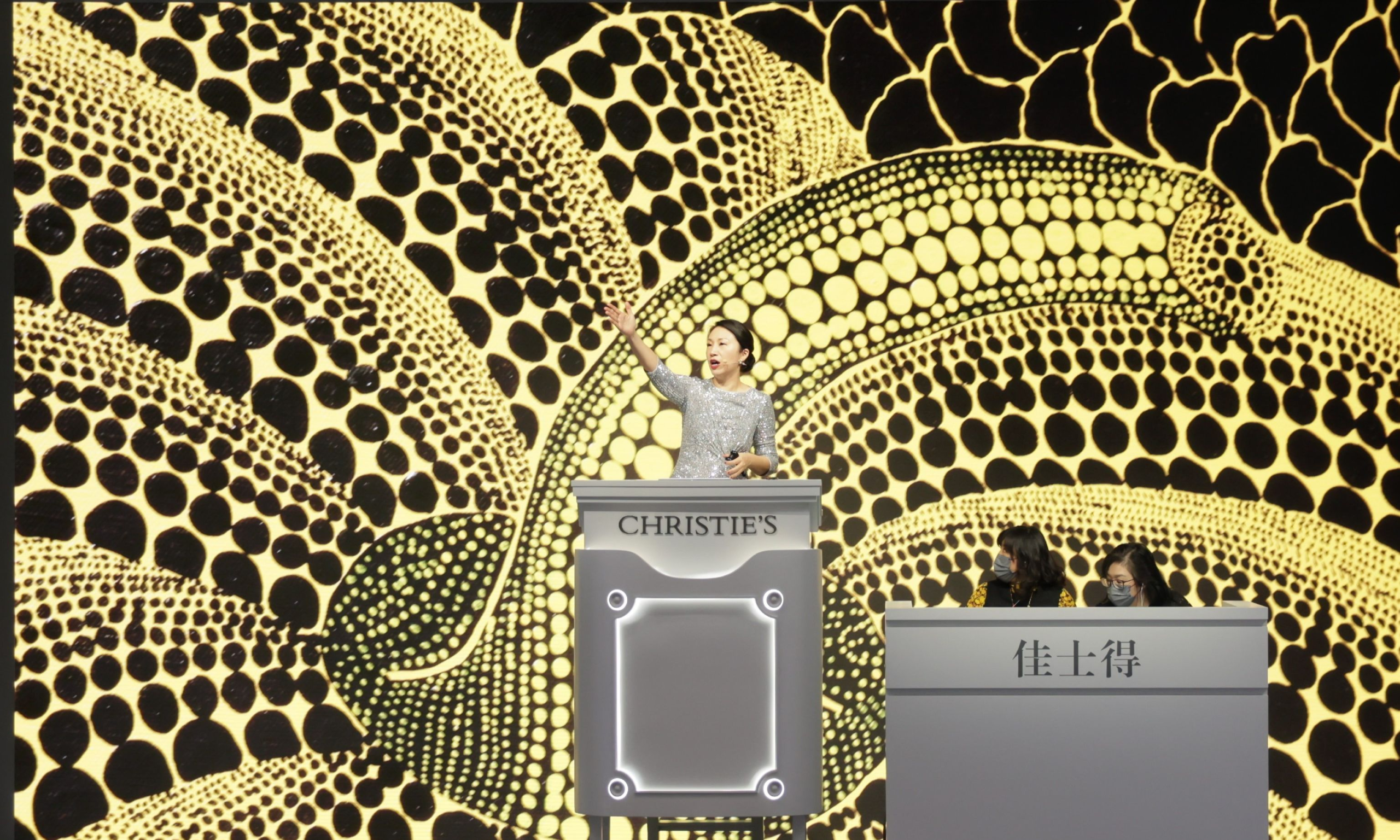Christie's auctioneer Elaine Kwok selling a record-setting Pumpkin by Yayoi Kusama for $495m in Hong Kong earlier this year
Courtesy of Christie's
Greater China’s sales of art at auction rebounded in 2020 following the initial outbreak of Covid-19, with the country accounting for 36% of the global auction art market in 2020, according to the latest China Art & Wealth White Paper.
Compiled by China International Capital Corporation (CICC) Wealth Management, the Central Academy of Fine Arts School of Arts Administration and Education and the Art Market Research Centre, the report found that domestic annual sales value dropped by 20% to RMB39.5bn (US$6.2bn), with 98,000 transactions. The average price of works sold was RMB400,000 ($62,795) and 51% of lots offered were sold, both record highs for China. While Chinese painting, calligraphy, antiques and porcelain still dominate auction sales, sales of oil painting and contemporary art rose by 3.3% to RMB 9.3bn ($1.4bn) from nearly 5,000 sales, averaging a price of RMB1.9m ($298,277).
“Due to tight controls on Covid in mainland China, recovery was very fast and very good, and auctions resumed faster than the rest of the world," says Shana Wu Shuang, who co-wrote and co-researched the report along with Dong Rui and Xu Wenhua. The Beijing region including neighboring Tianjin and Hebei particularly dominates sales figures, accounting for 53% of the national total (up from 44% in 2019) due to the rapid growth of new entrée Yongle Auction and the 2020 move from Guangzhou to Beijing of Huayi International. Holding fifth and sixth place respectively in the auction house rankings, Yongle Auction and Huayi International registered RMB3.3bn ($518m) and RMB2.6 bn ($408m) in sales. Beijing Poly continues to dominate despite a 14.2% drop in revenue, from RMB6.3bn ($989m) to RMB5.4bn ($847m), with Sotheby’s Hong Kong holding second place with a 12.1% decline from RMB6bn ($941m) to RMB5.3bn ($832m).
Shana Wu and Zhao Li, a professor at the Central Academy of Fine Arts, presenting the report at West Bund in Shanghai
Wu, who is a contributor to The Art Newspaper, says the report excludes sales data from the less open fairs and galleries (it simply is not available), hence skewing numbers to a low 11% (for both 2019 and 2020) for the Yangtze River Delta sales hub that includes the art fair and gallery hub of Shanghai. The auctions-only data found that transactions of works over RMB5m ($784,941) increased to 55% in 2020, from 48% in 2019, while middle (RMB100,000 to RMB5m) and low-end (under RMB100,000) sales declined, respectively, by 45.5% to 40% and 6.5% to 4.6% year-on-year.
Now in its third edition, the report for the first time surveyed 100 collectors reached via AMRC and CICC’s networks, based in Beijing, Shanghai and Hong Kong. Asked what their primary motivation to buy art is, 79% said passion, 53% said investment, while 34% have donated works to museums and non-profits. Auction was the primary mode of buying (69%), followed by galleries (62%) while 29% hire art advisors. Of their collections, 95% of respondents have works from greater China, 54% each have works from Europe and from the rest of Asia, and 31% have American art.
Although respondents were anonymous, Wu describes a Beijing musician who began collecting art to go on record covers, and a 1980s-born Sichuanese who collects and shows Chinese contemporary art as a way to promote Chinese culture. Despite a reputation as investment driven and flipping-prone, the Chinese collectors surveyed said they retained work for an average of six years, only slightly below Arts Economics’ global average of seven; 59% had resold works, and 14% kept their works more than eleven years. Respondents’ average time collecting was 13 years.
Wu anticipates that the 2021 report will show steady growth, “with no big changes up or down. It is a healthy development. Attitudes toward collecting are more reasonable compared to before, and more professional in understanding of prices. Speculators are fewer, and knowledge is higher."

